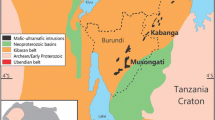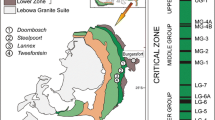Abstract
Platinum group elements (PGE) are strategic materials because 96–99% of the world production is derived from just five mining districts and because they cannot be replaced as catalysts in many chemical processes. In order to lessen the strategic character of PGE, both conventional deposits and unconventional PGE mineralizations were investigated in an attempt to locate viable deposits which would diversify the supplier base. In the Great Dyke, conventional PGE mineralization occurs in the form of pristine sulfide ores mined underground and oxidic surface ores. New observations such as bimodal distributions of the PGE in the Main Sulfide Zone (MSZ), elevated Pt/Pd ratios in the oxidized MSZ compared to the sulfidic part and distinct differences between the platinum group mineral (PGM) assemblages of the MSZ and stream sediments of adjacent rivers emphasize the fact that even though the Great Dyke seems to be the second or third largest PGE occurrence in the world, the complicated PGE distributions and supergene redistributions should be kept in mind during planning and mine operation. Investigations of unconventional PGE occurrences in ophiolites, Alaskan-type intrusions, porphyry copper deposits and in the Kupferschiefer show that economically exploitable PGE concentrations can be expected in a broader variety of host rocks than considered favourable in the past. In the Albanian Mirdita ophiolite average contents of 860 ppb Pt and 60 ppb Pd were detected. Flotation concentrates of porphyry copper deposits, for example from Mamut, Malaysia, Santo Tomas, Philippines, Elacite, Bulgaria, and Ok Tedi, Papua New Guinea, contain between 827 and 1860 ppb Pd + Pt. In selected profiles of the Polish Kupferschiefer average contents of 255 ppb Pt, 94 ppb Pd, 2.4 ppm Au and 13.0 ppm Ag were analysed. The distribution of the PGE resources in the world and the annual production rates, however, underline the fact that the chances for a significant change in the supplier base are relatively low. The Bushveld Complex will remain the largest producer, followed by Noril'sk-Talnakh, Sudbury and Stillwater. If the operations in the Great Dyke reach their planned capacities, the Great Dyke will rank in third place among the PGE-producing deposits in the world.
Similar content being viewed by others
Author information
Authors and Affiliations
Additional information
Received: 12 September 1998 / Accepted: 7 December 1999
Rights and permissions
About this article
Cite this article
Stribrny, B., Wellmer, FW., Burgath, KP. et al. Unconventional PGE occurrences and PGE mineralization in the Great Dyke: metallogenic and economic aspects. Mineral. Deposita 35, 260–280 (2000). https://doi.org/10.1007/s001260050019
Issue Date:
DOI: https://doi.org/10.1007/s001260050019




